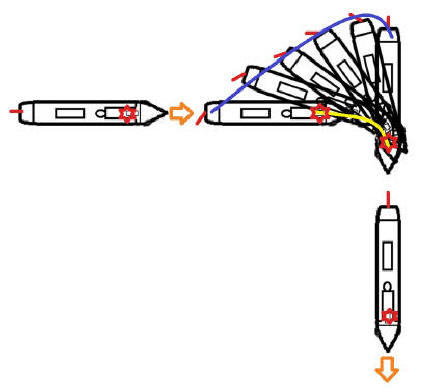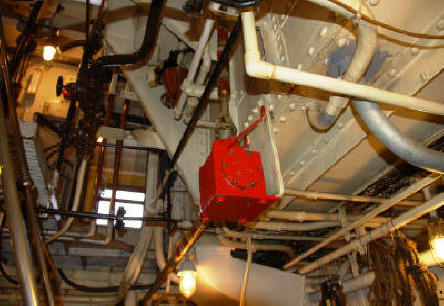STEERING

Ships are steered by rudders. These are moving plates at the back of
the ship that twist. These work in two ways, firstly by pushing the
water flowing away from the propeller away at an angle and secondly by
deflecting the water as it moves past the ship. This puts a force on
the rudder which acts on the bearings that hold it in place ( the pintle )
and this pushes the back of the ship sideways. The ship is long and
thin and this force acting on the back causes the ship to turn in the
direction of the rudder. However the front ( bow ) does not move
sideways very much - in fact the back ( stern ) of the ship swings out away
from the direction of turn and the ship then pivots about a point generally
about one third of the way along the length. This has the effect of
throwing the stern towards an obstruction before the ship starts to turn
away from it ( That is what did for the Titanic ! )

These are twin rudders and propellers on a scale
model. You can see rudders and the pintle where they enter the hull,
the propellers, the A brackets, tail shafts and stern glands. On this
ship the propellers are 'handed' so that they each turn a different way.
This makes the ship more directionally stable as any twisting effect from
the propellers are cancelled out. The real Balmoral has four bladed props !
HOW A RUDDER TURNS A SHIP.
In this diagram, the rudder is in red and the fulcrum or pivot point about
which the ship turns is the red star. The yellow lines shows the path
of the front of the ship and the blue line shows how the back takes a much
wider path which tends to tighten as the turn progresses. The ship turns
about a point about one third of the way along the hull. This diagram is
wildly exaggerated to show what happens!

FORCES ON A RUDDER

This is an attempt to show the forces acting on a rudder ! The propeller is
the blue disc with a yellow edge, the blue arrows show the water direction,
the red arrow shows the resulting thrust ( pushing force ) generated by the
propeller and rudder, and the orange arrow shows the direction in which the
back of the boat will try to go. The black arrow shows the path of the ship
through the water.
In the left hand diagram, the rudder is straight ahead and the
propeller wash and thrust are both going in a straight line. The ship moves
straight ahead.
In the right hand diagram, the rudder is turned to the left and is
deflecting some of the water from the propeller to the left. This puts
a sideways force on the rudder as the water changes direction when it
strikes the rudder and reacts
by pushing it the opposite way. This force which is
trying to push the rudder straight acts at an angle giving a turning
force which is transmitted through the rudder pintle to the back of the
ship. However there is still water flowing directly away in a straight
line behind the ship, so the turning effect is a combination of the sideways
force acting on the rudder and that pushing the ship along.
Because the rudder is at the back of the ship, the effect is to push the
back, away from the direction in which the rudder is turned, and because the
boat then pivots about a point towards the front, this causes it to turn in
the direction the rudder is pointing.
There are additional ways to steer ships. Some have bow rudders to
help push the front round, there are bow thrusters, ducted
propellers that push water through a tube across the inside of the
hull to move the front sideways , and it is possible to alter or reverse
one of the engines ( if the ship has more than one ) to help pull the bow
round. Most ships with two propellers will have two rudders, as a
rudder in the wash from the propeller will have far more effect than
one which relies on water passing it from the forward movement of the hull.
This is also a problem when trying to go backwards ( astern ). There
is no speed of water over the rudder and no propeller wash to help as
the water is flowing the wrong way ! Many ships have great difficulty
going astern, particularly at low speed and in some cases if there is only
one propeller and it is a big one, the turning effect of the screw can push the stern in
one direction regardless of which way the rudder points !
Rudders are big and heavy to be able to handle the forces applied to
them, a large ship like Balmoral needs steering gear. On early ships this
was a wooden rod ( tiller ) mounted on the top of the rudder shaft ( stock )
but this was difficult to control , especially in a rough sea, so a steering
wheel was introduced with ropes to link it to the tiller. This reduced
the effort needed to turn the rudder but required a lot more turns of the
wheel, and on sailing ships it could sometimes take several men to
hold the steering steady. As ships developed and used engines, the steering
position moved from directly above the rubber where ropes could be used to
move it, to a
position near the front. This required a linkage to take the movement
from the steering wheel right along the ship to the rudder and ropes didn't work as they were too
flexible. The force needed to
turn a large rudder was huge and only massive chains and shafts could transmit
the load - this wasn't practical, so someone had to invent the powered
steering gear system so that the person steering (helmsman)
could turn the wheel easily, there would be small linkages running the
length of the ship and a big powerful machine above the rudder to transmit
the movements from the input shaft to the steering. Originally this was
steam powered but modern ships, including Balmoral use a hydraulic system
driven by an electric motor.
STEERING GEAR
On Balmoral, the steering wheel is on the bridge in the wheel house.
It is connected by gears to a series of shafts that run down from the
bridge, through ceiling of the observation saloon and then into the engine
room. The shafts then continue along the side of the ship to the 'steering flat'.
This the area under the rear poop deck which houses the top of the rudder
stocks and the steering engine. This is a large hydraulically powered
pump that does the same job as a power steering system on a car. It
takes the control input from the steering shaft and applies it with much greater
force to the rudders. In this case as there are two rudders they are
linked with a rod so that they both move together.

The steering wheel is on the bridge and turns a series of shafts that run
through the ship .................
The input shaft from the steering wheel on the bridge is marked with red and
white tape , here the shaft is coming down from the deck house into the
engine room, through the red gearbox and out towards the side of the
ship to clear the engines ......

..... then it runs right along the inside of the hull and reaches the
steering flat where it has more gearboxes to bring the shaft back into
the middle of the ship, then it enters the red gearbox before going
aft..........

to the steering engine................

which amplifies the force from the man on the wheel and operates a hydraulic
ram that is connected to the rudders................

You can see the Port side tiller arm, the linking rod and part of the
control system painted red.....

........ and that system changes the direction of the rudders and controls
the ship. The propeller wash is deflected by the rudders and this greatly
improves the steering by pushing the water to one side. This is a photograph
of Balmoral in dry dock and you can see the propellers and rudders.
EMERGENCY STEERING
If the steering system fails, there is a small emergency steering wheel on
the poop deck and this can be connected to the rudder. The main
steering engine can then be disconnected from the final linkage and the ship
can be steered by hand. Its a hard job but better than having no
directional control at all!
Here is the emergency steering wheel and part of the emergency steering
system in the steering flat. The man at the wheel would be unable to
see where the ship was going but would be told how to steer by a chain of
people passing orders from the bridge - or he might be given a portable
walkie talkie radio !
In the event of steering failure it might be possible to steer the ship by
using the two engines at different power settings or even running one
backwards.
This is sometimes done to help manoeuvring and is known as 'splitting the
sticks' as the engine telegraph handles point in opposite directions.
It is not a good method of steering as the rudders have a very powerful
effect and unless they are dead straight they would have a huge effect on
the steering.

Emergency steering wheel.

Emergency linkage.

Emergency gearbox and steering rod.
In the right hand photograph, the bar with the red
clip ( clevis ) on top of the gearbox is the part that is connected to the
tiller arm on the right of the photograph when the emergency steering
is needed.
All this is contained under the poop deck at the very back of the ship.

HOME
